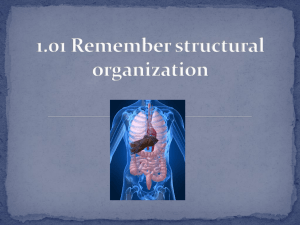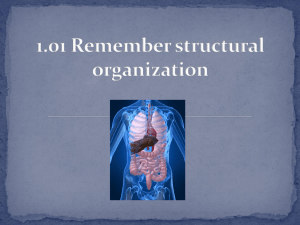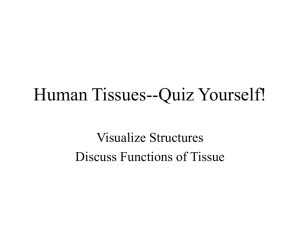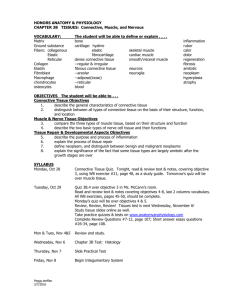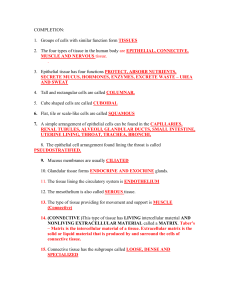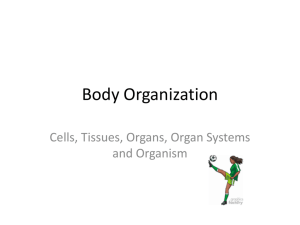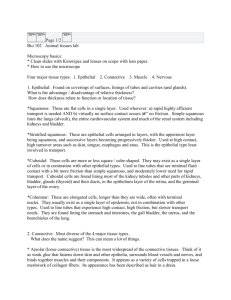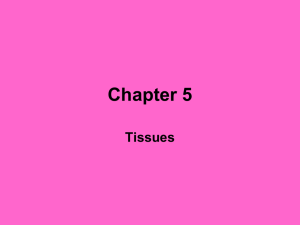Chapter 4 Tissues Notes
advertisement
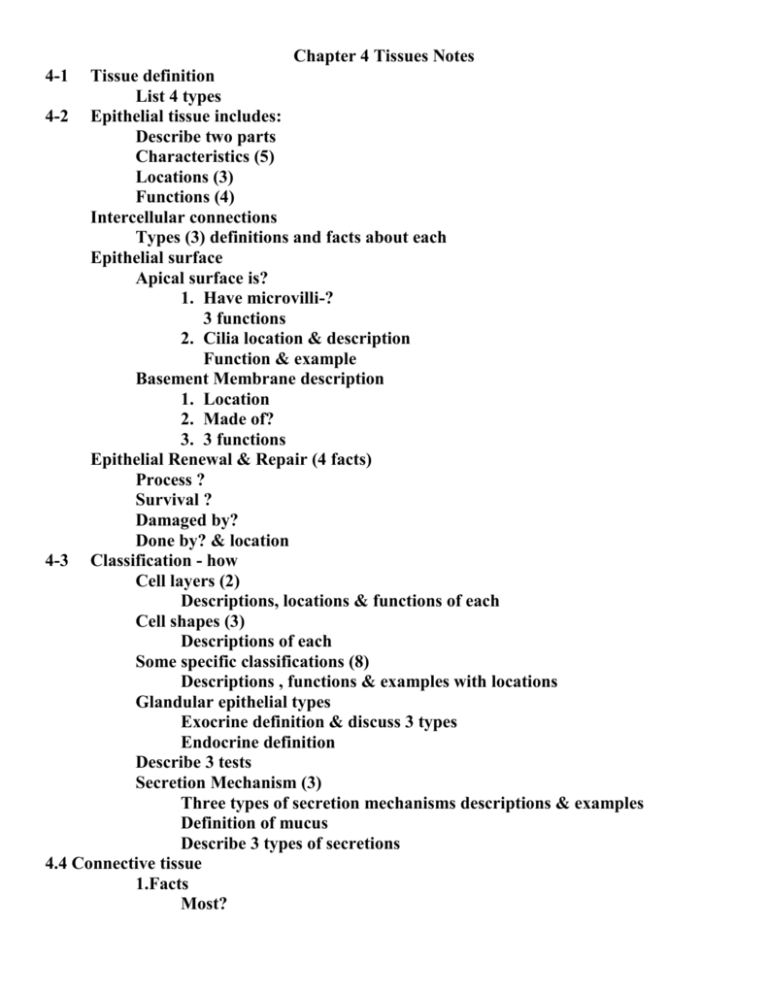
Chapter 4 Tissues Notes 4-1 Tissue definition List 4 types 4-2 Epithelial tissue includes: Describe two parts Characteristics (5) Locations (3) Functions (4) Intercellular connections Types (3) definitions and facts about each Epithelial surface Apical surface is? 1. Have microvilli-? 3 functions 2. Cilia location & description Function & example Basement Membrane description 1. Location 2. Made of? 3. 3 functions Epithelial Renewal & Repair (4 facts) Process ? Survival ? Damaged by? Done by? & location 4-3 Classification - how Cell layers (2) Descriptions, locations & functions of each Cell shapes (3) Descriptions of each Some specific classifications (8) Descriptions , functions & examples with locations Glandular epithelial types Exocrine definition & discuss 3 types Endocrine definition Describe 3 tests Secretion Mechanism (3) Three types of secretion mechanisms descriptions & examples Definition of mucus Describe 3 types of secretions 4.4 Connective tissue 1.Facts Most? All have 1. 2. 3. Matrix= Location? Contains ? & are? 2. Functions & examples (4) 3. Three major types B. Connective Tissue Proper 1. Cells a. Fibroblasts – most? Permanent? Produce? b. Fibrocytes – next? Maintain? c. Macrophages – found? Function Release? Can be ? or ? d. Fat cells = Life span What varies e. Mast cells – location Description Has vesicles – function f. White blood cells are? Produce? g. Antibodies definition 2. Connective Tissue Fibers Name & describe the three types. 3. Ground Substance a. Location b. description c. function C. Types of connective Tissue Proper 1. Loose- packing material of the body a. fills? b. Provides? c. Supports ? d. Anchor? e. Route 2. Dense – description a. Resists? b. Interconnects? c. Forms capsules? d. mostly e. 2 types Regular description & examples Irregular description & example 3. Fluid connective Tissue = a. Plasma = b. red blood cells (rbc) function c. White (wbc) function d. Platelets =? & function D. Supporting Connective tissue 1. Cartilage a. 2 characteristics b. Chondrocytes – definition Live in ? Get nutrients & eliminate waste by? Avascularity limits? c. Pericondrium function d. 3 types Hyaline – most? o Description o Example Elastic o Description o Example Fibrous o Description o Example o 3 functions 2. Bone – a. Has very small volume of? b. matrix = c. Description d. Lacunae with matrix o Has osteocytes – definition o Canaliculi definition o Periosteum definition 4-5 Membranes- definition 4 types 1. Mucous – lines? a. Examples b. Must be kept? 4-6 4-7 2. Serous – lines? a. Examples: Pleura – location Peritoneum – location Pericardium – location b. Has ? & ? portions c. Minimizes? d. Function of serous fluid 3. Cutaneous =? a. Covers ? b. Description 4. Synovial – lines? a. Fluid functions b. Made by? Muscle Tissue 1. Specialization for ? 2. 3 types a. Skeletal Muscle Cell description Called? Incapable of New come from Won’t contract ? Control? b. Cardiac Muscle Location Description Interconnected at? Repair? Lacking? Function of pacemaker cells Control? c. Smooth Muscle Location Description Filaments are? & no Able to (2 ) Control? Neural tissue = A. Specialized for? B. Location C. 2 types a. Neurons – communicate? b. Neuroglia 4-8 4-9 4 functions D. 3 facts about neurons E. 3 main parts List & describe Injury 2 Processes of Restoration A. Inflammation =? 1. Purpose 2. Signs & symptoms 3. Caused by (2) 4. Triggered by? Describe 7 Results B. Regeneration- definition 1. Scar – description 2. Overtime? 3. More successful in? 4. Different abilities in? 2 examples 5. Fibrosis –definition C. Control of phases – where & timing Age & Tissues A. List 3 items that decrease B. Describe what happens to epithelia, connective tissue, bones & blood vessels C. Cancer rates



